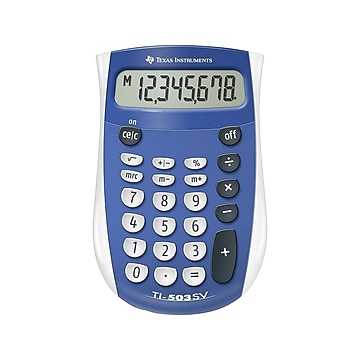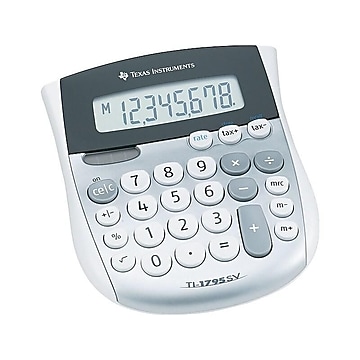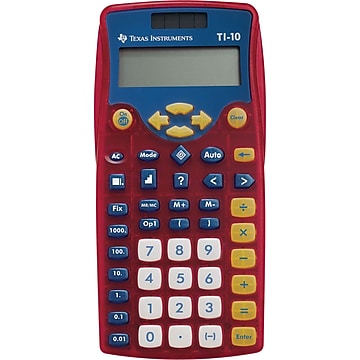Texas Instruments Calculators
Best Match
Grid view
Pick up and Delivery
Brand
Color Family
Rating
Number of Digits Displayed
Powered
Price
Related Searches
Trending now
Page 1 of 4
Texas Instruments® calculators are advanced computational devices. The company also provides the same innovative capabilities in a series of basic handheld calculators for elementary and high-school students, some of which are also ideal for home, office, and retail use. The instruments meet each user’s needs, whether learning basic mathematical functions or applying more complex ones. These powerful calculators can help students figure out business or household related financial computations, or apply sophisticated calculations encountered in advanced high-school math and science courses.
Texas Instruments Basic Calculators for Elementary Students
Several calculators enable young students to learn the fundamentals of mathematics and then hone their mathematical skills with more advanced computational work. Introductory calculators offer 8-digit displays for performing simple addition, subtraction, multiplication, and division operations, including automatic constant functions or repeat procedures for each operation. The calculators also introduce students to square roots, negative numbers, and inequality equations.
More advanced Texas Instruments calculators for young students include innovative devices that provide not only complex math functions but also flash-card learning exercises to introduce them to basic problem-solving skills. With 11 digits on each line of a two-line display, the calculators help students learn to compute place values from thousands down to thousandths, and to round up or down to whole numbers or decimals. Calculators also offer Texas Instruments’ Equation Operating System (EOS™) that lets students perform operations in a multiplication, division, addition, subtraction (M-D-A-S) hierarchy. The flash-card resource has three levels of difficulty with an internal progress-monitoring scoreboard, along with application guides for teachers.
Student-friendly Design
Texas Instruments calculators offer age appropriate features to invite young students to learn math skills. The calculators have large LCD readouts, many with SuperView™ screens that have oversize numbers. Keypads have extra-large, well-spaced keys color-coded by specific functions. The bodies have contour shapes for small hands, and they’re available in attractive colors. Many of the calculators also come with protective cases to prevent excessive wear.
Do Texas Instruments Basic Calculators Include Those for Advanced Students?
Texas Instruments offers four-line, 16-digit calculators to support advanced high school study in science and math, including algebra 1 and 2, geometry, statistics, biology, and chemistry. The calculators feature a wealth of computational formulas; fractional permutations and stacked-fraction math; trigonometric, hyperbolic, and logarithmic functions; angle conversion from degrees to radians to grads; random number and integer-set generation; statistical analysis using one and two variables; and fraction-decimal conversions.
The scientific calculators have central menus that offer edit and cut-paste options, as well as settings for shifting between classic math display mode, showing numbers along one line, and MathPrint™ mode, which displays numbers such as stacked-fractions equations as they appear in textbooks. Students may use many of the Texas Instruments scientific calculators to take their college placement or college credit exams.
How Do the Calculators Apply to Home, Office, and Retail Settings?
Some of the student-friendly features also make Texas Instruments calculators ideal for home or the workplace. In addition to large SuperView displays and dexterous keypads, some basic calculators have angled displays so users can place the handheld calculators on a work surface for ease of use. Some basic calculators also provide financial functions appropriate for home or business, including tax rate, percentage addition, and discounting computations.
How Are Texas Instruments Basic Calculators Powered?
Most of the elementary and basic calculators offer ANYLITE™ solar-power technology that keeps the devices charged with both natural and artificial illumination. Many have dual solar and battery power with 1.5-volt backup cells, and feature automatic power-down (APD™), a technology that shuts the calculator off after a period of inactivity.
Texas Instruments Basic Calculators for Elementary Students
Several calculators enable young students to learn the fundamentals of mathematics and then hone their mathematical skills with more advanced computational work. Introductory calculators offer 8-digit displays for performing simple addition, subtraction, multiplication, and division operations, including automatic constant functions or repeat procedures for each operation. The calculators also introduce students to square roots, negative numbers, and inequality equations.
More advanced Texas Instruments calculators for young students include innovative devices that provide not only complex math functions but also flash-card learning exercises to introduce them to basic problem-solving skills. With 11 digits on each line of a two-line display, the calculators help students learn to compute place values from thousands down to thousandths, and to round up or down to whole numbers or decimals. Calculators also offer Texas Instruments’ Equation Operating System (EOS™) that lets students perform operations in a multiplication, division, addition, subtraction (M-D-A-S) hierarchy. The flash-card resource has three levels of difficulty with an internal progress-monitoring scoreboard, along with application guides for teachers.
Student-friendly Design
Texas Instruments calculators offer age appropriate features to invite young students to learn math skills. The calculators have large LCD readouts, many with SuperView™ screens that have oversize numbers. Keypads have extra-large, well-spaced keys color-coded by specific functions. The bodies have contour shapes for small hands, and they’re available in attractive colors. Many of the calculators also come with protective cases to prevent excessive wear.
Do Texas Instruments Basic Calculators Include Those for Advanced Students?
Texas Instruments offers four-line, 16-digit calculators to support advanced high school study in science and math, including algebra 1 and 2, geometry, statistics, biology, and chemistry. The calculators feature a wealth of computational formulas; fractional permutations and stacked-fraction math; trigonometric, hyperbolic, and logarithmic functions; angle conversion from degrees to radians to grads; random number and integer-set generation; statistical analysis using one and two variables; and fraction-decimal conversions.
The scientific calculators have central menus that offer edit and cut-paste options, as well as settings for shifting between classic math display mode, showing numbers along one line, and MathPrint™ mode, which displays numbers such as stacked-fractions equations as they appear in textbooks. Students may use many of the Texas Instruments scientific calculators to take their college placement or college credit exams.
How Do the Calculators Apply to Home, Office, and Retail Settings?
Some of the student-friendly features also make Texas Instruments calculators ideal for home or the workplace. In addition to large SuperView displays and dexterous keypads, some basic calculators have angled displays so users can place the handheld calculators on a work surface for ease of use. Some basic calculators also provide financial functions appropriate for home or business, including tax rate, percentage addition, and discounting computations.
How Are Texas Instruments Basic Calculators Powered?
Most of the elementary and basic calculators offer ANYLITE™ solar-power technology that keeps the devices charged with both natural and artificial illumination. Many have dual solar and battery power with 1.5-volt backup cells, and feature automatic power-down (APD™), a technology that shuts the calculator off after a period of inactivity.















































